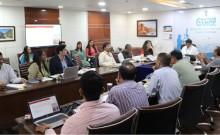
Rise in the water temperatures of Gulf of Maine within a century can be threatening for lobsters and the sea food industry, according to the latest research conducted by the University of Maine Darling Marine Center and Bigelow Laboratory for Ocean Sciences. The study got published in the ICES Journal of Marine Science on September 21, 2016.
This study focuses on the impact of ocean acidification and rise of temperature on the larvae of the American lobster.
Ocean acidification is an outcome of climate change, which leads to the entry of more carbon dioxide in our environment while turning the oceans more acidic.
This study revealed that the survival of young lobsters was not affected by ocean acidification, but the lobster larvae reared by the researchers in water with 3 degree higher temperature, which will be similar to that of the temperature in the Gulf of Maine by the year 2100, were found to struggle.
"They developed twice as fast as they did in the current temperature of 16 C (61 F), and they had noticeably lower survival," says Jesica Waller, the lead author of the study and a graduate student at the DMC.
"Really only a handful made it to the last larval stage," Waller stated. "We noticed it right from the start. We saw more dead larvae in the tank," Waller added.
The researchers also observed that ocean acidification could affect the behaviour and size of the larva. The researchers felt that these findings could help in better understanding of the future of the lobster industry.
Waller said that we can't depend on these short-term experiments to find out the possibility of lobsters adapting to the transforming climate conditions. She emphasised on researching more on this matter.
"It's critical to know how climate change will affect the future of our most important fishery," says Rick Wahle, the co-author and research professor from the University of Maine Darling Marine Center
"Last year, Maine harvested nearly half a billion dollars in lobsters. With lobsters now comprising over 80 percent of the state's overall fishery value, Maine's coastal economy is perilously dependent on this single fishery. We only need to look to the die-offs south of Cape Cod to see how climate change is having an impact," Wahle stated.
Waller started researching in June of 2015, when she raised more than 3,000 lobster larvae at the Bigelow Laboratory for Ocean Sciences till their larval stage got over. She analysed the survival rate, development time, weight, length, feeding rate, respiration rate and swimming speed of these lobsters daily for a month.
"We wanted to do all different types of measurements to provide a basis for our own research and for future work," she said.
The baby lobsters started eating each other because of their cannibalistic nature, this was challenging for the researchers. They managed to figure out how much space and food was needed by these lobsters.
Waller, from Sagamore, Massachusetts, is earning her master's degree in marine biology at the University of Maine School of Marine Sciences and is based at the Darling Marine Center.
"How copepods respond to climate change has important consequences for local fisheries in the Gulf of Maine," said David Fields, a co-adviser from Bigelow. "Like the lobsters, copepods in the North Atlantic, have seen their populations move northward over the past three decades," Fields said further.
Wahle and Fields believe that it would be very helpful in finding the effect of lobsters on the local economy if someone could suggest the exact impact of ocean acidification and rising temperature on lobsters.
With the help of Fields' ocean acidification system at Bigelow Laboratory, Waller evaluated Wahle's extensive knowledge about lobsters. "It just seemed like such a huge gap in our knowledge given how important the lobster industry is to the US," says Waller.
She even was awarded at the 2016 Vizzies award for the snap of a 3-week-old lobster larva that she clicked while conducting this research.





!['It's not Mumbai traffic, it's air traffic': Suriya apologises to Mumbai media after paparazzi yelled At Him for making them wait for hours [Watch]](https://data1.ibtimes.co.in/en/full/806234/its-not-mumbai-traffic-its-air-traffic-suriya-apologises-mumbai-media-after-paparazzi.jpg?w=220&h=138)
![Bigg Boss 16-fame Sreejita De and Michael Blohm-Pape exchange wedding vows in dreamy Bengali ceremony [Inside Pics]](https://data1.ibtimes.co.in/en/full/806233/bigg-boss-16-fame-sreejita-de-michael-blohm-pape-exchange-wedding-vows-dreamy-bengali-ceremony.jpg?w=220&h=138)






